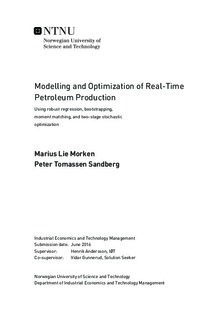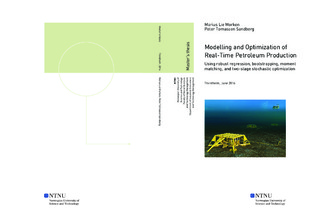| dc.description.abstract | This work is concerned with the upstream sector of the petroleum industry and seeks to
develop methods for real-time optimization of petroleum production under uncertainty.
The real-time production optimization problem deals with planning over a short time
horizon, where the objective is to maximize oil production. The output from the optimization
is a well defined plan of how the choke valves of the wells at the petroleum
field should be adjusted. In order to formulate an optimization model, models describing
the relationship between decision variables and production must be determined.
We call these models well models and evaluate different ways of constructing them.
The well models are then used to generate input for several optimization models. In
order to capture different aspects in the production optimization process and handle
the uncertainty in the input parameters, we apply stochastic programming techniques.
Three well models for modelling the relationship between production system settings
and production from the wells are presented. The first model, the export well model,
is built on the measurements of total exported production, while the second model,
the multiphase meter well model, applies the measurements from the individual wells.
The third model, the combined well model, uses all of these measurements, aiming to
reduce the uncertainty related to the individual well measurements by including the accumulated export production. Several different linear regression techniques are tested
for each model, and bootstrapping is used on the best model to find the probability
distributions for the well model parameters. Moment matching is thereafter applied to
generate a representative set of discrete scenarios. We handle the non-linear relationship
between the settings of the production system and production from the wells by
introducing a mode formulation. Instead of modelling the relationship for all possible
settings of the system, we only allow for settings within certain intervals, or operating
modes. The allowed modes are determined by the available historical data as a
combination of previously seen modes and modes that can be estimated based on the
available data.
In a case study of the petroleum field Gjøa in the North Sea, we show that the combined
model is preferred for modelling both oil and gas production. The robust linear
regression method Huber s T is found to be the best regression technique. Through
bootstrapping, we find that all the parameters for all wells have probability distributions
close to the normal distribution.
In order to include uncertainty in a proper way, two stochastic models which we name
the penalty model and the strategy model are developed. The assumptions behind
each of these models rely on insights from the company Solution Seeker AS on the
production optimization process. In the penalty model, a constraint can be violated
at a cost of lower oil production. The decision variables suggest how much each choke
valve should be adjusted to optimize production. In the strategy model, it is assumed
that changes to the production system are implemented slowly, so that it is observed
when the constraint is met. The decision variables suggest both how much each choke
should be adjusted and a sequence for the adjustments.
For the case study at Gjøa, we show that the stochastic models yield a small extra
improvement over the deterministic models. However, a potential for significant improvement
of oil production is found by applying either model. The solutions found
have very good in-sample and out-of-sample stability, especially when moment matching
is applied to create the scenario sets. From four synthetic cases, we find that the size
of the benefit of incorporating uncertainty in the models depend on the input parameters.
Uncertain oil prediction parameters give no additional benefit, while uncertain
gas prediction parameters give a small extra benefit using the stochastic models. The
penalty model and the strategy model usually return the same objective value, but
both models should be tested as variations can occur. | |

